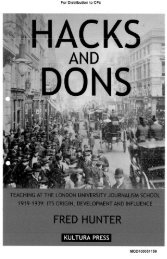The Edi ' - The Leveson Inquiry
The Edi ' - The Leveson Inquiry
The Edi ' - The Leveson Inquiry
You also want an ePaper? Increase the reach of your titles
YUMPU automatically turns print PDFs into web optimized ePapers that Google loves.
For Distribution to CPs<br />
~ reservatien of the anonymity af Minims Of sexual assault is<br />
|regarded as paramount under the Code and this clause is not<br />
subject to the defenca that publication is in the public interesL<br />
<strong>The</strong>re are cases where a victim may waive his or her anonymity or<br />
where identification has been permitted by the courts, and the Code<br />
provides for these, But the PCC has made clear that it is unlikely to<br />
recognise the legitimacy of any other claims that the identity of a sex<br />
victim is already in the public domain.<br />
Breaches are uncommon and almost always inadvertent. <strong>The</strong>y fal!<br />
nto two main categories:<br />
Those caused by poor training, carelessness -- or both, and<br />
Those resulting from the inclusion of some seemingly innocuous<br />
detail.<br />
Lack of training can lead to the most blatant breaches. A woman<br />
victim of an office sex eest was distressed and embarrassed when<br />
a local newseaeer resort of the man’s conviction broke at lhs rules<br />
and included her name, employment details and sexually e×elicit<br />
difficult to establish adequate justification u~ ees a court lifts the<br />
automatic Dan o~ identification of the victim n the ntarests of<br />
justice, or the victim waives their rights to anonymity.<br />
Even where they do -- uerhaus to warn others of dangers -- that<br />
cannot necessarily be taken as permitting continuing pub icity unless<br />
the victim maintains ~..onsent.<br />
n those rare cases where courts permit the naming of sex<br />
victims there are usual y substantial grounds for doing so and these<br />
would constitute adequate justification under the Code,<br />
Legal freedo~ to oublish may aucear relatively easy to establish,<br />
but it Is not always enougn under the Code. which aoolies in the Si3irit<br />
as we~ as the lette~<br />
<strong>The</strong> PCC uuheld a complaint against a newspaper whose reuort<br />
of a fade trial referred to evidence of what the VlCfim was wearing<br />
at the time of the attack and to her hobby<br />
<strong>The</strong> combination of details was sufficient to identify I~er to local<br />
residents and --even though the evidence had beer given in eden<br />
court-- the PCC held that the Code bound editors to rules over and<br />
above those st pulated by law and that anonymity should have been<br />
preserves ~ v~’nan v C ,d~;bank ~osL ~o~ 41. 199~<br />
In a similar case -- involving an assault on an under-age g ~,<br />
a weekly newspapers court reoort reference to the victim’s visible<br />
injury was sufficient to cause a braacn, even thougn no third party<br />
had actually identified he[<br />
<strong>The</strong> Commission ruled that while the mention of the injury might<br />
evidence. <strong>The</strong> editor, also deeply embarrassed, apotogised swiftly<br />
Because of staff holidays, an inexperienced reporter had prepared<br />
the story and sub-editore had missed the strait But apologies and<br />
promises to tighten up procedures were not enough. <strong>The</strong> PCC<br />
censured the newspaper for a breach so serious that any remedial<br />
action would have been inadequate. %1 ~.~r~p v M>scc/eshetd<br />
Fxs-~s& !~ez~ot! 7"4. 200~<br />
Even when newspapers follow the fundamental rules about not<br />
naming sex assault victims without consent, risks arise if they are<br />
identifiable by some detail in the story.<br />
For that reason the PCC has warned of the onerous burden this<br />
outs on editors and insists on ’scrupulous constTuction> of stories about<br />
sex comes to ensure strict adherence to the Code.<br />
Beware off:he evidence: Assessing likelihood at identification is a<br />
potential minefield when reporting both the original crime arid any<br />
....................... apparently insignificant to an outsider could<br />
De revealing to DOODle living ira Ioca community, who might<br />
otherwise not make the connection.<br />
A reuort of a redo, which gave details of the victim’s age, her<br />
health record and suecific details of the attack, as well as the town<br />
where the offence occurred, was ruled by the PCC to have been<br />
likely to identify he[ il~am÷s v;~s~ Pos~c~- v }%is o.’;~orz r;~,z~-m<br />
A~eqaate justification: As there is no uublic interest defence, t is<br />
have appeared insignificant, "it was a superfluous but specific detait<br />
which could have Dean sufficient to identify her, or confirm the<br />
suspicions of those who already knew something about the case."<br />
<strong>The</strong> editor could have taken greater cars by omitting the reference<br />
<strong>The</strong> complaint, and corresponding breaches in Clause 5 [Intrusio~<br />
into Grief or Shock) and Clause 6 (Children), were ueheld<br />
- "ideS;St< V "% le~Ssnk PO~; (£~eoo,’~ 4G 998<br />
A WO!’~, %, Stt~;~i ~nmy S ~s#Nomn P?e~S,O /F::eL:OM /’~* 20£<br />
75<br />
MOD100036650
















